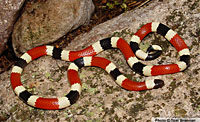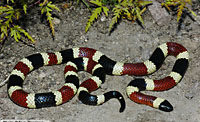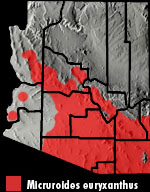Online Field Guide to The Reptiles and Amphibians of Arizona


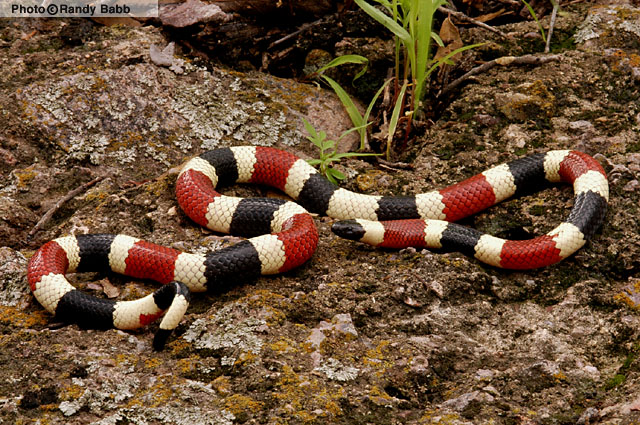
Santa Cruz County, AZ
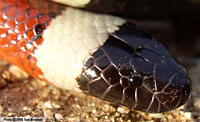 Maricopa Co., AZ |
| SONORAN CORALSNAKE Micruroides euryxanthus |
Venomous
|
| DESCRIPTION: A small (up to 615 mm or 24″ in total length), slender, brightly-colored snake with red, yellow or cream, and black rings that completely encircle the body. The red bands touch the yellow bands. The scales in the dorsal portion of the red bands often have black edges creating a net-like pattern over the red. Some specimens are marked with heavy black speckling or mottling in the dorsal portion of the red bands. The head and snout are black. The tail usually lacks red bands. The cloacal scute is red on Arizona specimens. The blunt head is barely distinct from the neck and the tail is relatively short and blunt. The pupils are round and the scales are smooth and shiny. Its black snout distinguishes this snake from the similar looking Western Shovel-nosed Snake and Sonoran Shovel-nosed Snake.
DISTRIBUTION: This snake is found across most of the southern portion of the state below approximately 6,000′ elevation. Its distribution in the low deserts of western Arizona is spotty and poorly known. HABITAT: The Sonoran Coral Snake is found in communities ranging form Sonoran, Mohave, and Chihuahuan desertscrubs, through Semidesert Grassland, and into the lower reaches of the woodlands. It is usually encountered above the flats in or near rocky or gravelly drainages, mesquite lined washes, and canyons. DIET: Like other Elapids this snake feeds primarily on ectotherms. It uses its neurotoxic venom to subdue a variety of small snakes including threadsnakes, groundsnake’s, and black-headed snakes. It also occasionally feeds on small lizards. REPRODUCTION: A clutch of up to 3 eggs is laid during the summer monsoon (July-August). REMARKS: This is Arizona’s only representative from the Elapidae, a family of snakes that includes mambas, cobras, kraits, and taipans. It delivers neurotoxic venom through fixed, hollow fangs in the front of the mouth. There have been no reported deaths from its bite in Arizona but this snake should be considered dangerous and should not be handled. By Thomas C. Brennan Bartlett. 2000. Snakes of North America: Western Brennan, T. C., and A. T. Holycross. 2006. A Field Guide to Amphibians and Reptiles in Arizona. Arizona Game and Fish Department. Phoenix, AZ Brennan, T. C., and A. T. Holycross. 2005. A Field Guide to Amphibians and Reptiles of Maricopa County. Arizona Game and Fish Department. Phoenix, AZ Degenhardt, W. G., Painter, C. W., and Price, A. H.. 1996. Amphibians and Reptiles of New Mexico. University of New Mexico Press. Albuquerque.
Lowe, Schwalbe, Johnson. 1986. The Venomous Reptiles of Arizona. Nongame Branch Stebbins. 1985. Western Reptiles and Amphibians. Houghton Mifflin. New York, NY |
|
Visit Partners in Amphibian and Reptile Conservation:


HOME
Copyright © 2023, Arizona Game and Fish Department. All rights reserved.
If you make use of the textual contents of this site in reports, publications, etc. please cite and credit the author(s) and photographer(s). All photos on this website are copyrighted. However, those found in the species account section may be used for any noncommercial scientific, educational, or conservation purposes provided that photographs are not altered and continue to bear the copyright symbol and name of the photographer. Please contact the photographer regarding commercial use of copyrighted photographs.










